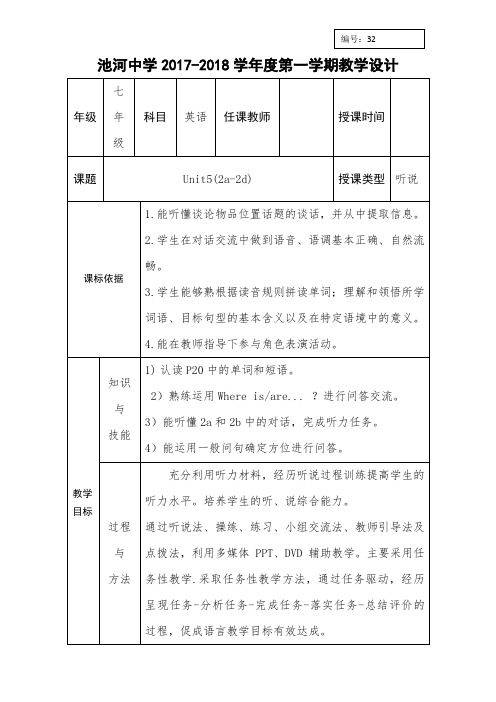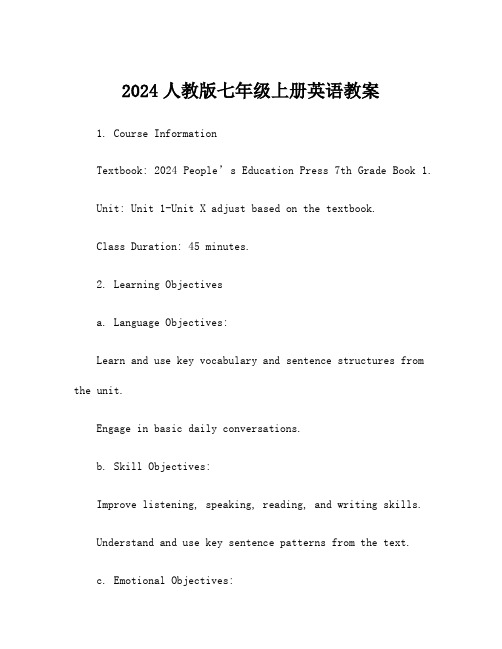人教版七年级英语上册Unit 5教案
- 格式:docx
- 大小:338.26 KB
- 文档页数:39

人教版(新目标)初中七上Starter Unit 1 Good morning!教案教学目标:1. 学会打招呼的用语:Hello! / Good morning! / Good afternoon! / Good evening!2. 识别和掌握八个人名: Alice, Bob, Cindy, Dale, Eric, Frank, Grace, Helen教学重点、难点:1.词汇:Alice, Bob, Cindy, Dale, Eric, Frank, Grace, Helen2.句型:Hello! Good morning!教学过程:Step 1. Warming-up1. 课前—上课铃响教师就播放Good morning歌曲。
2. 师生初次见面,教师通过自我介绍和问候学生,让学生放轻松,消除与教师间的陌生感,开始亲近教师。
教师自我介绍并用Hello! / Good morning! 问候学生。
帮助学生用Hello! / Good morning! 作回应。
Step 2. Play a game.绝大多数学生都会背诵26个字母表,因此学生参与这个游戏会相当积极。
通过这个游戏首先可以锻炼他们迅速反应的能力;以英语名字作为奖励(老师提前准备好很多的英文名字),也使学生较有新鲜感,让他们自己选择自己的名字,使他们会更容易记住自己的名字。
Play the game like this: Teacher says a letter, for example C, then let the Students tell the letters whichis before and after C. The one who says B, D first is the winner. The winner can get a chance to choose an English name first.Step 3. Presentation1.用预先制作的图片或挂图介绍八个人物和姓名。

池河中学2017-2018学年度第一学期教学设计年级七年级科目英语任课教师授课时间课题Unit5(2a-2d) 授课类型听说课标依据1.能听懂谈论物品位置话题的谈话,并从中提取信息。
2.学生在对话交流中做到语音、语调基本正确、自然流畅。
3.学生能够熟根据读音规则拼读单词;理解和领悟所学词语、目标句型的基本含义以及在特定语境中的意义。
4.能在教师指导下参与角色表演活动。
教学目标知识与技能1)认读P20中的单词和短语。
2)熟练运用Where is/are... ?进行问答交流。
3)能听懂2a和2b中的对话,完成听力任务。
4)能运用一般问句确定方位进行问答。
过程与方法充分利用听力材料,经历听说过程训练提高学生的听力水平。
培养学生的听、说综合能力。
通过听说法、操练、练习、小组交流法、教师引导法及点拨法,利用多媒体PPT、DVD辅助教学。
主要采用任务性教学.采取任务性教学方法,通过任务驱动,经历呈现任务-分析任务-完成任务-落实任务-总结评价的过程,促成语言教学目标有效达成。
编号:32方法:利用非听力因素来辅助理解,提高听力效率:(1)充分利用听力文中图片,场景的观察和判断;培养学生的观察能力(2)利用听力材料所给的文字线索,训练和提高学生的听力水平。
利用非听力因素辅助理解是一种重要的听力策略,而根据不同的听力任务决定采取何种具体做法便是对听力技巧的训练。
通过模仿2d情景对话,培养学生的听、说综合能力。
情感态度与价值观1.积极参与与学习活动。
2.关注并接受异国文化差异。
3.养成爱整洁、合理摆放物品的好习惯。
教学重点难点教学重点1.学习P20词汇2.Where is/are...It’s/They arein/on/under....3.2c中的一般问句及其回答。
教学难点1.一般问句及其语调语调2.名词单复数的变化。
教学过程师生活动设计意图设计 Step1Warming up and revision.1.Duty report2.Make dialogues with the word in 1a like: A:Where is/are the...?B:It ’s 、They are in/on under... (对话操练中关注学生是否能正确使用名词单复数使其情况加以点拨。

七年级上册英语教案人教版免费(经典版)编制人:__________________审核人:__________________审批人:__________________编制单位:__________________编制时间:____年____月____日序言下载提示:该文档是本店铺精心编制而成的,希望大家下载后,能够帮助大家解决实际问题。
文档下载后可定制修改,请根据实际需要进行调整和使用,谢谢!并且,本店铺为大家提供各种类型的经典范文,如工作总结、述职报告、策划方案、演讲致辞、合同协议、条据文书、教案资料、好词好句、作文大全、其他范文等等,想了解不同范文格式和写法,敬请关注!Download tips: This document is carefully compiled by this editor. I hope that after you download it, it can help you solve practical problems. The document can be customized and modified after downloading, please adjust and use it according to actual needs, thank you!Moreover, our store provides various types of classic sample essays for everyone, such as work summaries, job reports, planning plans, speeches, contract agreements, doctrinal documents, lesson plans, good words and sentences, complete essays, and other sample essays. If you want to learn about different sample formats and writing methods, please pay attention!七年级上册英语教案人教版免费最新七年级上册英语教案人教版免费(8篇)作为一位不辞辛劳的人·民教师,通常会被要求编写教案,那么关于七年级上册英语教案怎么写呢?以下是本店铺准备的一些七年级上册英语教案人教版免费,仅供参考。


人教版(新目标)初中七上Starter Unit 1 Good morning!教案Period OneTeaching aims:1. Greetings:Hello! / Good morning! / Good afternoon! / Good evening!2. Know eight English name: Alice, Bob, Cindy, Dale, Eric, Frank, Grace, HelenTeaching importance and difficulty:1.Words:Alice, Bob, Cindy, Dale, Eric, Frank, Grace, Helen2.Sentence:Hello! Good morning!Teaching procedure:Step 1. Warming-up1. Music:Good morning, it will raise students interesting.2. Teacher introduce myself. Example: Say Hello! / Good morning! Let student answer by Hello! / Good morning!Step 2. Play a game.Play the game like this: Teacher says a letter, for example C, then ask which is before and after C. The one who says B, D first is the winner. The winner can get a chance to choose an English name first.(Teacher prepare many English name at the first)Step 3. Presentation.Show the clock and let the students guess what they will say. This way could motivate students to think by themselves and know how to use good morning.Step4. Work on 1a.See 1a and figure out boy’ s name and girls name. Be good at sharping observation.Step5. Work on 1b. Listen and repeat.Listen the type and could speak three conversation.Step6. Work on 1c.Practice the 1a three conversations and teacher move around the class in order to help the students. And teacher encourage students to practice the conversation by using their names.Step7.Homework1.Be familiar with boy’s name and girls’ name。

2024人教版七年级上册英语教案1. Course InformationTextbook: 2024 People’s Education Press 7th Grade Book 1.Unit: Unit 1-Unit X adjust based on the textbook.Class Duration: 45 minutes.2. Learning Objectivesa. Language Objectives:Learn and use key vocabulary and sentence structures from the unit.Engage in basic daily conversations.b. Skill Objectives:Improve listening, speaking, reading, and writing skills.Understand and use key sentence patterns from the text.c. Emotional Objectives:Foster interest and confidence in learning English.Enhance teamwork and communication skills.3. Lesson ContentText: Dialogues, short texts, and stories from the unit.Vocabulary: New words and phrases from the unit.Grammar: Key grammar points from the unit.Functional Sentences: Core sentences and expressions from the unit.4. Teaching Stepsa. Introduction (5 minutes)Use images, videos, or questions to introduce the lesson theme.Engage students and outline the learning objectives.b. New Content (15 minutes)Vocabulary: Introduce and explain new words, focusing on pronunciation, spelling, and meaning.Grammar: Explain key grammar points with examples.Sentence Patterns: Demonstrate core sentence structures and practice.c. Text Learning (10 minutes)Read the text aloud and discuss its content.Engage in group discussions or role-plays to practice dialogues.d. Practice (10 minutes)Complete related exercises such as fill-in-the-blanks, matching, and multiple-choice questions.Use group activities or games to reinforce vocabulary and sentence structures.f. Summary and Homework (5 minutes)Review the lesson’s content and address any student questions.Assign homework, such as vocabulary practice, writing tasks, or reading assignments.5. Homework AssignmentsVocabulary Practice: Complete exercises from the textbook.Writing Task: Write a short paragraph using the new vocabulary and sentence structures.Listening Exercise: Listen to recordings and complete related comprehension questions.6. AssessmentOral Evaluation: Assess student participation and performance in class.Written Evaluation: Evaluate homework and exercise accuracy.7. ReflectionReflect on the effectiveness of the lesson based on student feedback and observation.Note areas for improvement for future lessons.。
Unit5 单元教材分析在本单元中,学生要通过完成任务来掌握如何询问别人拥有的东西,并会阐述自己的感受和想法。
通过一般疑问句do/does的提问来回答拥有物品的情况;通过一些形容词的学习来说明自己对事情的感受。
在开放式的教学过程中学生完成任务的同时,能够达到区分各种体育运动及用品的名称,询问他人的喜好并提出建议,以及准确表达对事物的好恶的水平。
本单元教学的主要内容是:学习have的一般现在时的疑问句及其肯定和否定回答,该话题与学生的日常生活紧密联系在一起,容易唤起学生的学习兴趣,这对于提高学生的综合能力很有帮助,特别是说的能力。
本单元仍将继续学习一般现在时,这是一个生活中离不开的时态,也是最基本的一个时态。
新课程标准要求学生重点掌握一般现在时,这在英语中使用频率很高,学好这一时态的用法对以后其他时态的学习和交际有很大的帮助。
体育用品词汇的掌握及区分。
教师可以找一些实例来区分,如:basketball,soccer,volleyball;也可以借助一些图片、录像资源给学生们视觉上的直观感受,如:baseball,golf。
表达好恶的形容词不容易掌握和区分,需要教师们列举更多的实例来解释形容词的意义及用法。
单元教学设想思路一:本单元单词较简单,部分单词教学可以以总结分类的方法进行,球类:basketball,volleyball, baseball, ping-pong, soccer ball,形容词:relaxing, boring, interesting, fun, 动词:do, watch, play, let 等。
其余单词的学习可以在学习句子时教学,重点单词用法可以由学生预习总结归纳,并开展小组比赛,提高学生的积极性,对于学生不能自行解决的问题,教师做补充,并接着给出相应练习。
同时对个别单词的发音给予提醒。
思路二:对本单元的语法教学,采用总结对比的方式,对于第三人称单数,如,he,she,it,Paul,Mike’s mother,用到does,doesn’t,对于非第三人称单数,如I,we,you,they,my parents 等用到do,don’t 的,对比分析后得出其用法,功能与话题部分,与现实生活较为贴近,通过pair work,group work,reading,writing 等方法,让学生反复操练,从而达到熟练应用的目的。
B:Yes,I do.知识点拨▲have(1)have意为“有”,表示某人拥有某物。
have在句子中有两种形式,即have和has。
have用于第一人称(I,we)、第二人称(you)以及第三人称复数(they)和其他复数名词;而has则用于第三人称单数(he,she,it)和单数名词。
如:I have an apple.我有一个苹果。
Mary has an orange.玛丽有一个橙子。
(1)have/has句子的一般疑问句是在句首加助动词do或does,句尾用问号构成。
第三人称单数和单数名词前加does后,句中的谓语动词has应改为have。
作简略回答时,肯定回答为“Yes,主语+do/does.”,否定回答为“No,主语+don't/doesn't.”。
板书设计:T:Oh,what a pity!You don't have a basketball.Do you have a volleyball?S:Yes,I do.T:Nice.Let's play volleyball.S:That sounds good.Step 3畅通Grammar Focus回顾语法重点Read Grammar Focus and practice these sentences.Step 4完成教材3a-3b的任务1.学生将3a方框中的单词填入表格中正确的位置。
2.学生用表格中的单词造句,比一比,看谁写得又快又对。
3.学生用do或does填写3b中的空白补全对话,然后结伴练习对话,邀请几个小组展示。
Step 5完成教材3c的任务学生记住鲍勃房间里的物品,然后合上书模仿3c中的对话,与同伴问答,然后结对练习。
知识点拨▲英语中的人称和数人称汉语主格助动词宾格单数第一人称我Idome 第二人称你you you 第三人称他hedoeshim她she her它it it复数第一人称我们wedous 第二人称你们you you 第三人称他/她/它们they them ▲实义动词的一般疑问句结构(1)当主语是第一人称/第二人称/第三人称复数/复数名词时,句型结构为:Do+主语+动词原形+其他?知识点拨▲let's=let uslet sb. do sth.意为“让某人做某事”。
人教版七年级英语上册(全册)精品全英教案汇总一、Unit 1Lesson 1- Title: Greetings and Introductions- Objective: To learn basic greetings and introductions- Time: 40 minutes- Materials: PowerPoint presentation, flashcards, handouts- Procedure:1. Warm-up: Greet the students and introduce yourself.2. Presentation:- Introduce basic questions for introductions.3. Practice:- Divide the students into pairs or small groups.- Give each group a set of flashcards with different greetings and responses.- Have the students take turns greeting each other and responding.4. Production:- Distribute handouts with a list of questions for introductions.- Have the students interview each other using the questions.5. Conclusion: Recap the lesson and highlight key phrases.Lesson 2- Title: Numbers and Classroom Objects- Objective: To learn numbers and classroom objects- Time: 45 minutes- Materials: PowerPoint presentation, flashcards, real objects- Procedure:1. Warm-up: Review the greetings from the previous lesson.2. Presentation:- Introduce numbers 1-100 using visual aids.- Teach vocabulary related to classroom objects.3. Practice:- Show flashcards with different numbers and have the students say them aloud.- Bring in real classroom objects and ask the students to identify them.4. Production:- Divide the students into groups.- Give each group a set of number flashcards and object cards.- Have the students match the numbers with the corresponding objects.5. Conclusion: Recap the lesson and review the vocabulary.二、Unit 2Lesson 1- Title: Personal Information- Objective: To learn how to talk about personal information- Time: 40 minutes- Materials: PowerPoint presentation, worksheets- Procedure:1. Warm-up: Review the numbers from the previous unit.2. Presentation:- Teach vocabulary related to personal information (name, age, nationality, etc.).- Introduce basic sentence structures for talking about personal information.3. Practice:- Distribute worksheets with fill-in-the-blank sentences.4. Production:- Divide the students into pairs.- Instruct them to interview each other and ask about personal information.5. Conclusion: Recap the lesson and encourage the students to practice asking and answering questions about personal information.Lesson 2- Title: Colors and Clothes- Objective: To learn colors and clothing vocabulary- Time: 45 minutes- Materials: PowerPoint presentation, flashcards, colored paper - Procedure:1. Warm-up: Review the vocabulary from the previous lesson.2. Presentation:- Introduce basic colors using visual aids.- Teach vocabulary related to clothing.3. Practice:- Show flashcards with different colors and have the students say them aloud.- Show flashcards with different clothing items and have the students identify them.4. Production:- Give each student a piece of colored paper.- Instruct them to draw and label a piece of clothing using the color of the paper.5. Conclusion: Recap the lesson and review the vocabulary.三、Unit 3... (continue to provide summaries for each lesson in Unit 3 and subsequent units)Please note that the above are just examples of how the document could be structured. You can provide detailed summaries of each lesson in the "Unit X" section, following a similar format. Remember to adapt the content to fit the actual lessons and materials provided in the textbook.。
Unit 5 Do you have a soccer ball? 话题Topic 与朋友共度快乐时光Spending time with friends 功能Functions 能够询问并描述物品的所属关系Talk about ownership A:Do you have a ping-pong bat? B:Yes, I do./No, I don’t. A:Does she have a tennis ball? B:Yes, she does./No, she doesn’t. I don’t have a computer game. He has two ping-pong bats.
语法Grammar 一、能够正确使用动词have在一般现在时中的用法The simple present tense to have Do you have a volleyball? Does she have a tennis ball? We have a basketball. They don’t have a basketball. He doesn’t have a soccer ball. She has a baseball. 二、能正确使用一般疑问句询问物品的所属关系并作简略回答Yes/No questions and short answers A:Do you have a tennis ball, Jane? B:Yes, I do./No, I don’t. A:Does he have a soccer ball? B:Yes, he does./No, he doesn’t. 三、能够正确使用形容词对事物发表基本看法 Adjectives of quality interesting, difficult, boring, relaxing, fun 四、能够正确使用连词but Conjunction words I don’t have a soccer ball, but my brother Alan does.
词汇和常用表达 Words & expressions
1.能正确使用下列词汇Curriculum words 名词:tennis, ball, soccer, volleyball, basketball, TV, sport, class, classmate;代词:us, we, them;形容词:late, great, interesting, boring, fun, difficult, relaxing, same,easy;动词:do(does), have(has), let, go, get, play, sound, watch, love, like;其他: with,only, after 2.能正确使用下列常用表达Useful expressions soccer ball, tennis ball, watch TV, after class, play computer games, play volleyball, play basketball, ping-pong 3.能够认读下列词汇Non-curriculum words bat,hey 学习策略 Strategies 1.预测文章大意 2.将所学单词按语义场分类:体育运动词汇、描述性词汇
文化知识Culture 1.了解国内外中学生常见的体育运动 2.理解体育锻炼与身体健康的关系
三维目标 Three-dimensional target 知识与技能 1.能掌握以下单词:do(does), have, tennis, ball, ping-pong, soccer, volleyball, basketball, let, us, go, we, late, has, get, great, play, sound, interesting, boring, fun, difficult, relaxing, watch, TV, same, love, with, sport, them, only, like, easy, after, class, classmate 2.熟练掌握单元短语: watch TV, after class, play computer games, play volleyball, play basketball,let’s go 3.能掌握以下句型: A:Do you have a ping-pong bat? B:Yes, I do./No, I don’t. A:Does he/she have a soccer ball? B:Yes, he/she does./No, he/she doesn’t. A:Do they have a basketball? B:Yes, they do./No, they don’t. I/They have a volleyball. He/She has two ping-pong bats. 4.能了解以下语法:学习实义动词have在一般现在时中的用法;学习一般现在时中各种人称作主语的肯定句、否定句和一般疑问句的构成以及回答。
过程与方法 1.通过师生问答、两两对话、角色扮演等多种言语交际活动,培养口语交际能力和在日常生活中运用英语的能力。 2.通过图片提供出物体的名称,运用实际例子,学习Do you have…? 和Does he have …? 句型及答语。 3.开展结对活动,了解学生们有什么,没有什么,并能对他人的活动进行评价。
情感态度与价值观
1.理解体育锻炼与身体健康的关系。
2.激发学生学习英语的欲望和兴趣,使他们乐于参与各种英语实践活动。
Section A 概述 1.本部分主要学习球类运动的单词,学习have(has)在一般现在时中的用法,学习使用一般疑问句询问物品的所属关系并作简略回答,还学习使用句型Let’s….提建议,进行交际。 2.1a-1c是Section A所学内容的基础。本部分首先通过主题图片呈现本单元的基本词汇和句型。本课时的主题以国外普通家庭的客厅为背景,画面中还呈现了放置在不同位置的各种常见的球类运动用品,呈现句型:Do you have …? 回答用Yes, I do./No, I don’t.,这是整个单元话题展开的基础。 3.2a-2c通过听力编号、匹配信息、就所听内容进行问答等活动帮助学生巩固运用新的词汇和句型,让学生继续学习实义动词have在一般现在时中的用法及一般疑问句的用法,并学习Let’s….句型。 4.2d示范对话集中呈现了I have …Do you have …? Let’s …等句型,它涵盖了Section A所有重点语言知识,是有更高要求的综合性的语言运用活动。
教学 目标
1.学会使用由助动词do/does引导的一般疑问句。
2.初步认识简单的祈使句。 3.能运用 have/has进行简单的语句写作。
Section B 概述 1.Section B在Section A的基础上进行话题内容拓展,主要学习使用形容词来描述体育活动,将形容词和体育活动的名词以及相关动词结合起来。 2.活动1a 是听前活动,让学生先学习描述性形容词interesting, fun, relaxing, boring difficult。 3.活动1b-1c让学生在听力活动中继续巩固使用have(has)表达物品的所属关系。在听力活动中,学生还将学习球类名词与相关动词的搭配。 4.1d是听后的语言输出活动,要求学生两人一组分角色表演1b和1c的对话,重点训练本单元的另外两个重点句型Let’s ….和That sounds ….以及描述性形容词的运用。 5.活动2a-2c的内容是一个整体:2a巩固词汇,2b-2c是阅读理解活动。 6.活动3a-3c是整个单元的语言输出练习,是对单元目标语言的运用。3a首先复习含有动词have的一般疑问句及其肯定和否定回答。3b要求学生口头输出、操练3a中的句型。3c进一步提高要求,让学生根据3a的内容,结合同伴和自己的实际情况,写出含有动词have的肯定句和否定句,并学习使用转折连词but。本部分在复习和巩固本单元所学知识的基础上,发展学生综合运用语言进行书面表达的能力。 教学 目标 1.掌握do/does引导的一般疑问句。 2.能运用目标语言进行写作。
Self Check 概述 1.活动1要求学生列出有关体育运动的词汇,并对其发表观点。 2.活动2在活动1的基础上帮助学生从词汇的复习过渡到对句子的复习,要求学生根据设置的情景补充每组对话所缺失的内容。
1.掌握本单元的词汇及短语。 2.学会用 have对物品的所属关系进行提问与回答。 3.学会用“Let’s …”句型提建议。 4.能够谈论自己喜欢的球类运动,不喜欢的球类运动及原因。 从学生们的日常饮食入手,选取最贴近生活的素材,让学生流利的说出自己和他人喜欢什么,不喜欢什么。能够较为熟练地掌握have的用法。能用形容词描述自己的活动。 教学突破:运用调查问卷的方式,让学生们调查自己的同学有什么,没有什么。充分利用课本上的插图,让学生观察图片写出图中的物品,以此提高学生运用目标语言的能力,增强学生们的合作能力。创设语境,突出听力和口语表达,通过自制表格增强学生的动手能力。为学生呈现写作框架,以此来帮助他们提高写作能力,突破写作的瓶颈。听力练习可适当加强,可以增加听力的时间。让学生在听力的基础上,自由地表达,提高他们的口语能力。 注意方法与价值观的培养:通过任务型活动,使学生们在实际生活中均衡饮食,合理配餐。让学生在小组活动中培养交际能力。
第一课时:Section A 1a-1c 第二课时:Section A 2a-3c 第三课时:Section B 1a-2c 第四课时:Section B 3a-Self Check
教学 目标 单词 卡片 名词:tennis, ball, soccer, volleyball, basketball, TV, sport, class, classmate, bat 动词:do(does), have (has), let,go,get, play, sound, watch, love, like 代词:us, we, them 形容词:late, great, interesting, boring, fun, difficult, relaxing, same, easy 副词: only 其他:with, after, hey